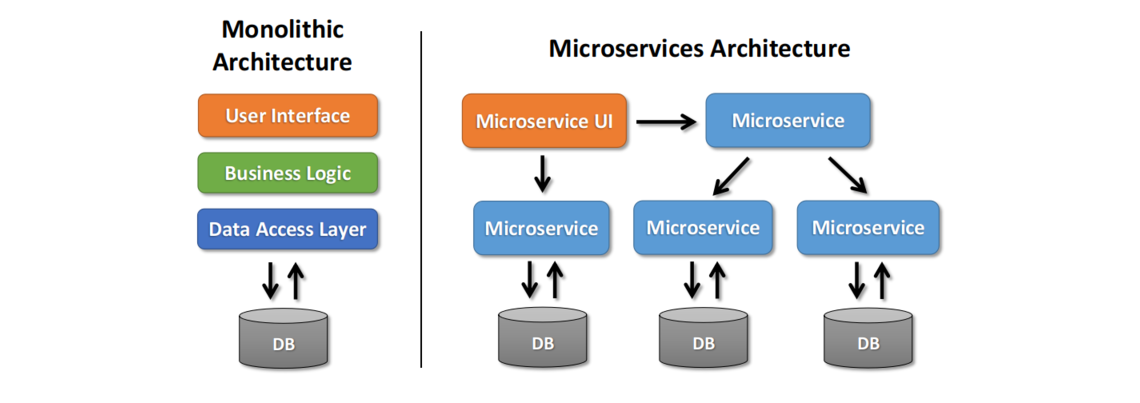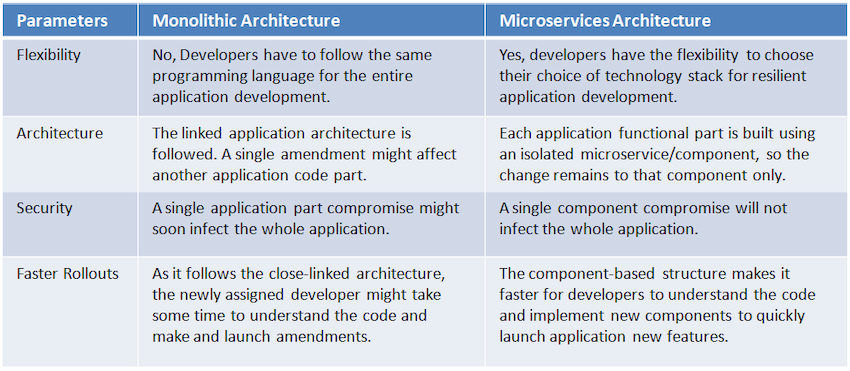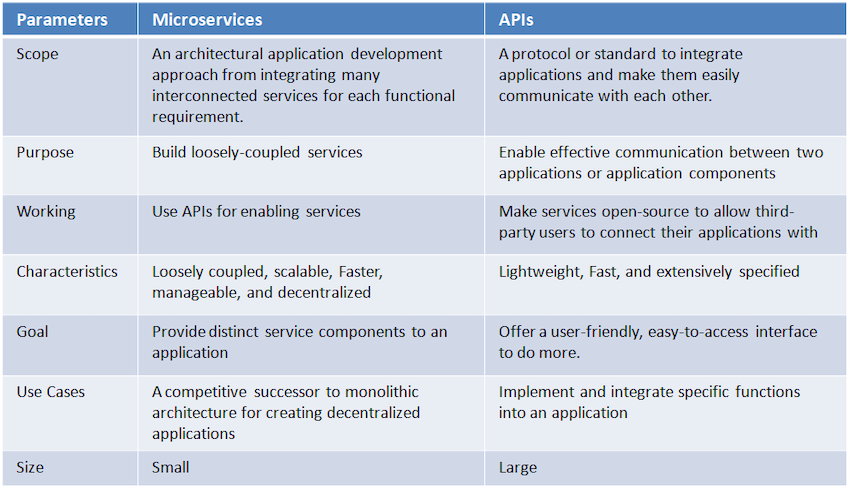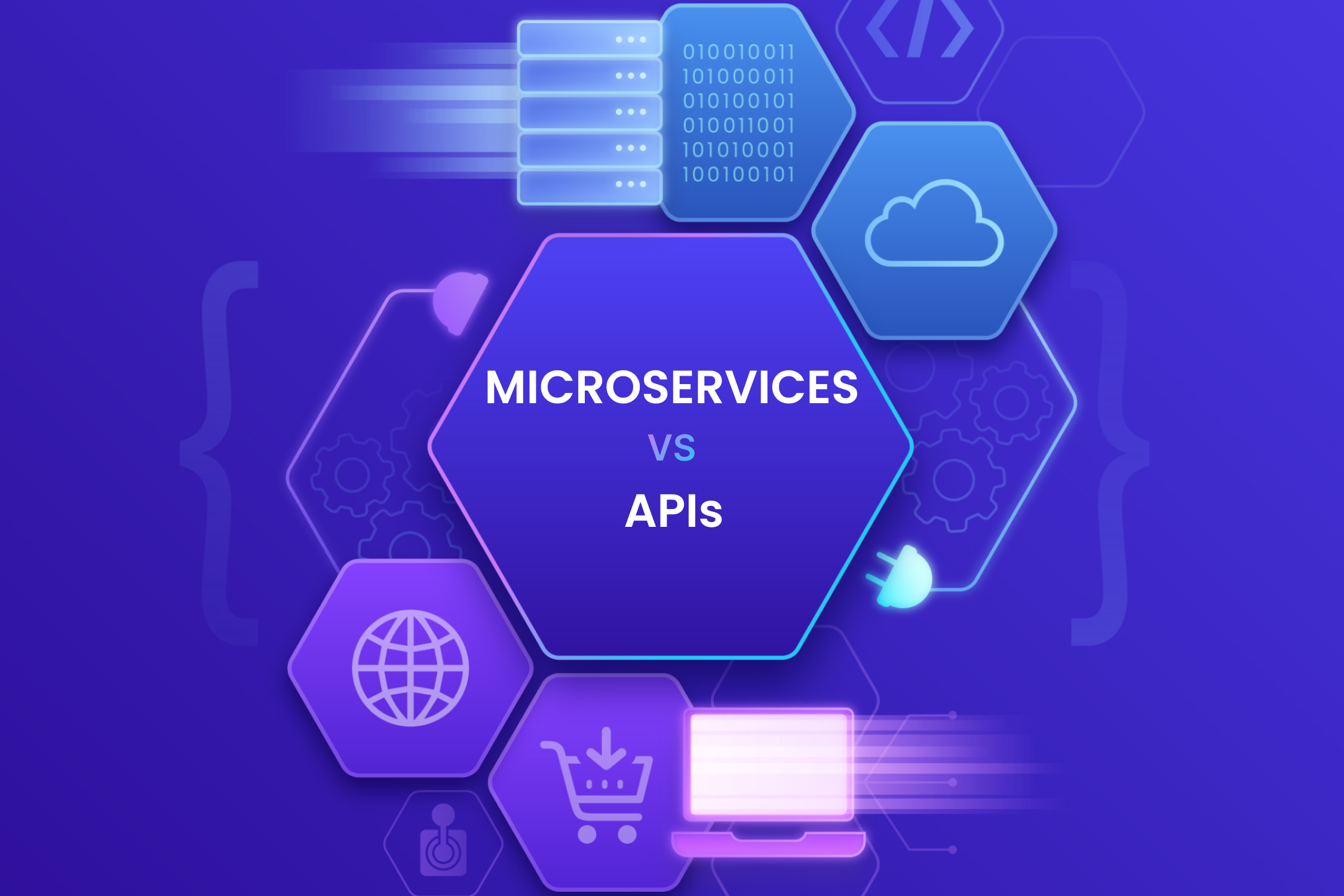Microservices Vs APIs: Citing Clear Differences
- DevOps
- August 17, 2022
Nowadays, achieving digital transformation in businesses, meaning shifting business processes to a digital platform, is becoming a growing trend across global industries. And the COVID-19 pandemic has become the boosting era for this sudden digital adoption amongst businesses.
When you hear about digital transformation, the first thing that comes to mind is shifting businesses-critical processes and data to the cloud platform. Well, you guessed it right! But this digital transformation can also be said when shifting processes to on-premises or private network-based software solutions.
But when planning to build mission-critical digital solutions, many business leaders find difficulties in deciding on the right software product engineering approach. And that is whether to use microservices architecture or the API integration method to build a full-fledged software product.
Some people also have confusion whether Microservices and APIs are simple concepts or not. Well, it is a serious and debatable concept, which must be discussed with in-depth research.
This blog will guide you through all Microservices and APIs’ differences, their reliance on each other, and much more.
What is a Microservice?
Microservices, though by name, seems like or represent a small action development part, but itself a broad development topic covering in-depth development keys to build a full-fledged, optimized, and secure software solution.

Microservices are defined in two contexts:
- Microservice is a loosely-coupled software development architecture helping to develop a large and complex software solution by creating and integrating multiple small development components together.
- And a small, tiny development component can also be represented as a Microservice.
In simple words, Microservices are a collection of small development components, when gathered together – create an extensive, flexible software product.
Working Experience With Microservices – A Hot Debatable Topic Amongst Developers
Technically, the term microservices means the approach of dividing application development into granular, self-contained services coded in different programming languages, which interact over lightweight protocols.
With microservices privileging developers and businesses to choose programming languages by not being constrained to a particular technology stack, developers can build software in an iterative fashion, which also benefits from quick software time-to-market and flexible upgrades releases.
Popular Microservices-Based Software Products
With increasing awareness of microservices-based software development, below are the popular software applications developed in microservices architecture:
- Amazon – A Global Retail Marketplace
- Netflix – An Online Video Streaming Platform
- Paynow – A Fund Transfer Service
- Uber – A Car Booking Services
- Etsy – A Retail Marketplace
Why Should Businesses Focus On Developing Microservices?
Seeing Microservices with the Monolithic software development architecture is the best practice to understand and value the need for Microservices architecture in mission-critical and large software development.

The benefits of using Microservices in software development are as follows:
1. Flexibility
When choosing a Microservices architecture, developers receive the flexibility to select a technology stack that works best for them and also in terms of build resiliency. They can pick any programming language to code a particular service in the best way regardless of its impact on other application components.
In simple terms, developers can build the app the way it pleases them to bring the most out of the development process and facilitate users with the best-in-class app user experience.
2. Coherent Structure Leading to Quick Update Release
As the application is built using microservices architecture, all application development components are isolated from each other. So, when a new developer is assigned to work on these application feature updates, he/she can easily understand the application code structure, work on code edits, and quickly release the updates.
3. Better Team Curation
Microservices generate specific roles for each team associated with the application development, while DevOps engineers can be assigned with one or more microservices than any specific microservice component.
4. Utmost Security
As microservices-based applications are built from various isolated components, so if any components get compromised, no other components would get affected.
5. Resilient Architecture
Due to the isolated and well-distributed architecture of microservices-based applications, any changes in any application component will remain limited to it rather than impacting other application components. Hence, it proves that microservices-based applications have resilient architecture.
Microservices-Based Product Development Best Practices
To make your microservices-based software development effective, you should follow the below-mentioned microservices development best practices.
- Create a Domain Driven Design (DDD) by considering its strategic phase (business capability architecture) and tactical phase (application domain model), improving the development productivity.
- Employ the Single Responsibility Principle (SRP) to reduce dependencies to deal with new requests or failures.
- Create a data persistence layer for each microservice of the application.
- Promote application component parallelism with asynchronous communication.
- Integrate API gateway request transformation plugin to encounter broken APIs and alert API owners with deprecation notices and original API responses.
- Run your microservices architecture in Kubernetes or VMs to obtain a centralized hub to enforce security policies.
What is an API?
The term API stands for Application Programming Interface – a part of an application, software interface, or protocol that defines ways for two applications to communicate, modify each other’s data, or for any other purposes. APIs are also called software solutions, focusing on a particular service.

Technically speaking, APIs are usually implemented and stored between the software core components and the application front-end interface.
To provide your software the ability to perform a particular task or borrow that functionality from a third-party service provider, developers need to build APIs or integrate third-party APIs with their software solution. In the case of integrating a third-party API, developers need to refer to the high-level API reference document, best practices, or guidelines provided by the owners.
Types of APIs
You will find APIs built for many different applications, but there are majorly two types of APIs, which are as follows:
- Internal APIs are the ones used for only internal application use cases, such as in-app communication, and are restricted to authorized development and business management team members.
- External APIs are the ones with which third-party APIs and resources are integrated to share public company data with associated third parties. e.g., SaaS applications, public cloud services, etc.
Popular API Design Styles:
There are countless API design styles available in the market, but the followings are the most popular amongst developers:
- REST APIs stand for Representational State Transfer APIs, which are built from the REST framework with the aim of cross-platform integration. These APIs can also be used in microservices. The REST APIs work on HTTP requests and represent findings in JSON format.
- SOAP APIs stand for Simple Object Access Protocol APIs, which allow processes using OS, like Linux and Windows, to communicate using HTTP and XML formats. By integrating your application with this API – your solution can create, update, drop (delete), and recover records, like profiles, login credentials, etc.
- GraphQL APIs get you faster and stable predictable results in an organized manner on your raised queries as they have access to all application data source points, even when your device internet connection is slow.
The Role of APIs in The Software Development
APIs are the most versatile tools to build your mission-critical applications that allow developers to:
- Create Containerized-based APIs
- Use different languages, like Java, Python, Go, etc.
- Deploy applications on public cloud platforms
APIs boost the usefulness of your services and make the service distribution easier. Hence, you can offer granular services.
Taking APIs as a product that processes alongside a developer portal. Hence, developers are informed about the usages of APIs with access to an API key. The developer portal will demonstrate:
- The purpose and procedure of the service
- Data structure and Schema
- The API development requirements
Read also: A Step-by-Step Guide to API Development
As you’re now aware of today’s two-star topics, let’s dive into the difference between Microservices and APIs.
How Do Microservices and APIs Differ From Each Other?
As you can see that APIs and Microservices have many similarities and are used together in the development architecture; thus, comparing them might be a bit misleading. Why are we saying this?
Let’s understand this appeal through their definitions:
Microservices is a software development approach, breaking development into modular components, while APIs are more like an application communication tool, enabling cross-application communications. Hence, factfully, APIs help developers trigger and energize microservices to build a resilient mission-critical application with faster time-to-market.
Likewise to an application that uses external APIs to integrate with other public APIs, each microservices component has its private API to get access to different microservices architectural components.
Important Note:
No microservices are the same; thus, all microservices have their unique different APIs. APIs have extensive pros than microservices as APIs allow inter-system data-sharing, which is sometimes necessary for many applications. And APIs are lone wolfs as, unlike microservices, they don’t need support from microservices during implementation.
As a concern of comparing Microservices and APIs, they can be differentiated by the following parameters:

The Impact of APIs on Microservices
The API is an application communication tool that enables the communication between two services. Reality check, though APIs are an effective service package, they need to be integrated with other services or microservices in order to become useful, which could be:
- Function as a Service
- Machine Learning as a Service
- Software as a Service
You could also say that APIs are the brain of microservices, which makes them connected and distributes microservices with users. Moreover, APIs help microservices to step out of their sort of monolithic architecture and gain decentralized characteristics for what they are created.
Best Practices for Microservices Management Using APIs
The best thing about microservices and APIs is that they both can be used together and the ways are mentioned below:
1. Employ Composable Enterprise Approach
The composable enterprise architecture was introduced by Gartner to work with this emerging IT trend, which is built upon Packaged Business Capabilities to enable:
- Infrastructure as an application (IaaS)
- Infrastructure automation (IaC)
- Multi-cloud Governance & Orchestration
- Portfolio rationalization
2. Microservice Security
In Microservices architecture, security should be the top-most priority, especially in the case of Service Mesh. To effectively secure a Service Mesh, you need to use protective APIs and an API Gateway – for the service encapsulation.
3. Transformation
Deeply understand your application microservices architecture and the working of microservices, which will help you find the components and loopholes to harden your microservices-based application and boost its performance. This microservices-based application optimization best practice will help you provide a value solution to your application user base.
Employ the Software Development Revolution
Many people are thinking about dividing software implementation work into granular parts, like APIs and Microservices components is a new and modern approach. But in reality, this software architecture has been extensively followed by many leading digital services providers like Amazon, Netflix, Spotify, and many others.
Indeed, the synergy of APIs and Microservices is bringing a revolution in the software development approach and its stakeholders’ collaborations with efficiency. Moreover, the software implementation development may cost more, but worth it to get the most reliable, stable, faster, resilient, and secure IT solution.
Need experts’ guidance on how to optimize your software development? Consult the proficient software engineers at MindInventory today!
FAQs About Microservices Vs APIs
As Microservices are more like a software architecture and design style, there are possibilities to build Microservices without REST APIs. However, utilizing RESTful API architecture to implement Microservices would make the development process smoother and faster and help to achieve decentralized, loosely coupled microservices’ characteristics.
In most cases, UI structure is considered a monolithic way of developing an application. However, to make your Microservice development approach more advanced, you can use the “Micro Front-ends” to design your app UI following Microservices architecture.
After seeing the usefulness and benefits of using microservices-based applications, Microservices development has become a buzzword across businesses. And for such development, you’ll need to define your development budget.
For that, you’ll need to focus on many app development and management factors, such as the scale of update, frequent Microservices’ maintenance requirements, engineering demands, distributed systems, database transactional system implementation requirements, time across the cluster, foreign keys, and Ad-Hoc querying system.
There are many other Microservices application development cost factors as well, depending on your mission-critical software development requirements.
The expert web and mobile application developers at MindInventory can help you define your app development requirements with cost constraints as well. Want to know how? Contact us today!













